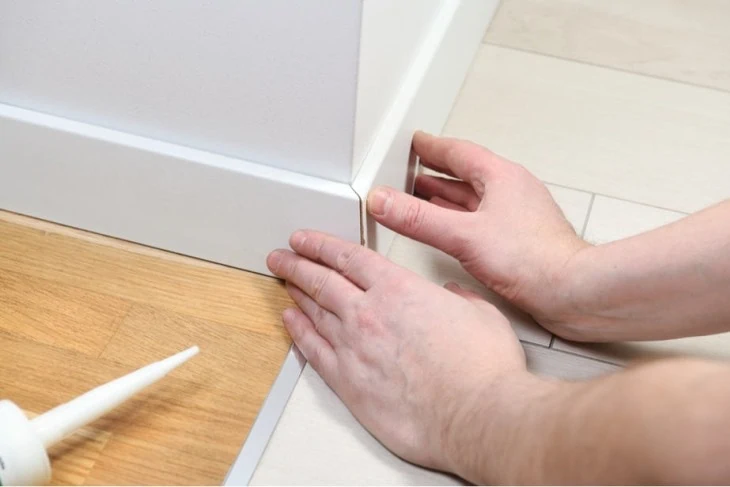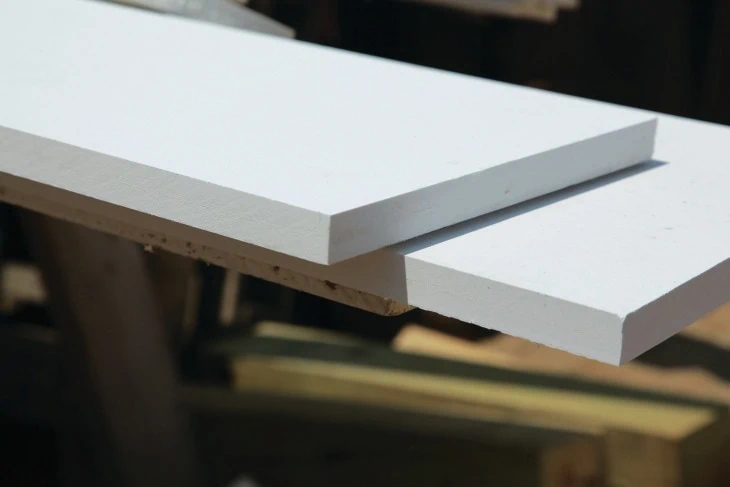Choosing the right material for your baseboard might not seem like a significant consideration. However, baseboards tend to take a lot of damage over time. Between kicking, hitting the baseboard with a rolling chair, or moisture problems, there is a lot that can go wrong over time.
Your main options for baseboard materials are MDF, wood, and PVC. Other options like PFJ, LDF, and less commonly used types of wood like poplar are also available. Wood is usually preferred if you can afford high-quality material. MDF is a more affordable option, and PVC should be used with extra caution due to its fragility.
MDF

Medium-density fibreboard (MDF) is a type of composite wood. It’s lighter than regular wood and tends to resist moisture damage very well. On the other hand, it can get damaged easily by physical contact.
MDF is probably the most popular baseboard material right now. It offers a good balance between price and durability and is easy to find in many areas. When it comes to choosing between MDF vs wood for trim work, many experts would recommend MDF.
Rooms with more unusual layouts that feature curved walls are perfect for MDF baseboards due to the flexible nature of the material.
If you’re installing your baseboard in a room that will likely see a lot of foot traffic, MDF might not be the best option. It’s more likely to get damaged over time. In addition, MDF can’t be stained – though it can be painted, and ideally should be.
Wood
Oak, pine, and maple are the main types of wood used for baseboards. One major advantage of wood like pine vs MDF for baseboards is that wood can be stained and painted. It’s also stronger and can withstand physical damage much more reliably.
This comes at a price – wood is almost always more expensive than MDF, unless you’re willing to go with a cheap, low-grade type of wood. In addition, wood is relatively inflexible compared to MDF, so it’s only suitable for straight walls.
PVC

PVC is a synthetic plastic that is lighter and more customizable than both MDF and wood. You can paint PVC in any color without ruining its look, and it can fit the decoration style of most modern homes.
PVC is significantly more expensive than both other options, on the other hand. And while it’s impervious to water damage, it’s very fragile. One small hit can easily leave a dent or even a large hole in your PVC baseboard.
It isn’t easy to compare PVC vs MDF for baseboard use. Both materials have very specific purposes and are intended for specific applications.
And when that happens, it’s usually impossible to repair the damage. The entire section of the baseboard has to be replaced. Cutting out the affected area is also difficult, as PVC is trickier to cut properly.
PVC is still the most popular option among completely synthetic materials though. Polystyrene is occasionally suggested as well. However, using polystyrene vs PVC for trim work has some significant disadvantages and is only recommended for temporary situations.
Other Options
Those are the most popular options on the market. They’re not the only ones available though. Here are some alternatives you might want to consider.
PFJ

Finger jointed pine (somewhat confusingly abbreviated to PFJ) is a type of wood manufactured by cutting standard pine in a toothed pattern, joining two pieces together, and using adhesive to permanently bind them.
PFJ tends to be stronger than regular pine but is also more expensive. It can also be a bit unsightly if it’s not painted properly. Despite the additional strength, however, it’s still based on softwood and therefore susceptible to physical damage.
LDF
LDF is more commonly known as particle board. It’s another type of composite wood, and is one of the cheapest options available on the market.
LDF is not used for baseboards often for several reasons. It looks unappealing, even when painted thoroughly. It’s also very fragile and can break more easily than MDF. Still, if you are on a tight budget and have no other options, LDF can work in a pinch. It’s a good idea to plan for a replacement in the near future, however.
Poplar
Despite its relatively low popularity, poplar is actually a solid choice for a baseboard. It’s not expensive and is quite strong. However, it can also be more difficult to work with for beginners. Poplar is commonly used when a stylish look is a must. It can be painted in a variety of colors and will always look good.
Conclusion
There are several popular options for baseboard materials that most people usually go with. However, the trim market offers much more than that. It’s in your best interest to look into alternative options, especially if your rooms have an unusual layout or you’re going for a specific decoration style.

